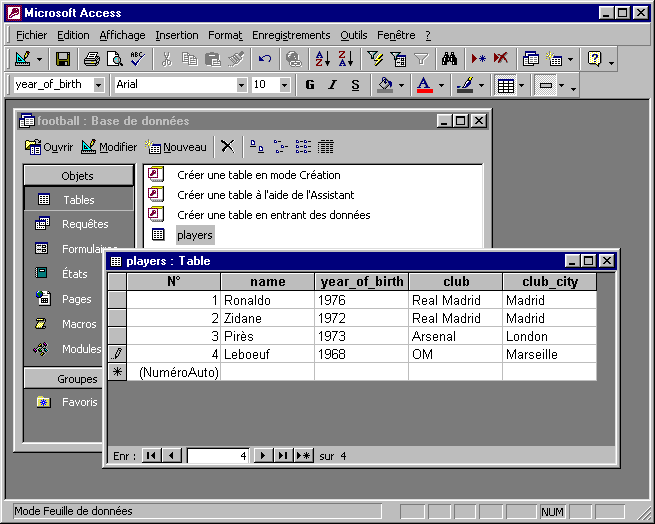NTIC course
Lecture 4 : Databases and dynamic pages
Databases
- Let's create a new Access database
- New document, no wizard... (...to start with. Wizards are OK, but they prevent you from understanding exactly what's going on)
- Creation of a table (a new "cardboard box" - no card yet ; not even the card structure)

- Define the structure of a card
- Define fields
- Decide the type of each field
- In the table mode (also called the "data entering mode" as opposed to the "card structure design mode"), fill in fields with data

- Advanced possibilities example : set the Input Mask (in Design the table, modify a field) to a specified shape
- Create a Form. And display the data in the "Form" form (i.e. as a set of cards, as opposed to rows in a table). Insert photos.

- Creating from scratch or using the Wizard
- Let's use the Wizard
- Let's create a "List of Contacts" database (with their personal coordinates, and their firm coordinates)
- Or - alternative option - let's create a database from the first Internet reference below : the database of historical travel books
- The problem of replicating data : too much room taken, unnecessary work, risk of mistakes in entering the data
- In the case of our "football" database, we are replicating information about clubs (the city).
- The two types of databases we can create with Access: 1) the simplest database (also called "one table database", also called "two dimensional database"), and 2) the multitable database (also called "relational database")
- Details : a database with two tables, i.e. the first kind of...
- ...relational database
- How to create a relation between two tables. (We can use the powerful "Analysis" tool, or do it by hand). Choose the fields that will hold the link.
- The new look of our database

- Less space used, less risk of mistaken entries, and less work (!)
- A document established by extracting information from two tables
- Modeling a database is an art, not a hard science
- Modeling with UML
Dynamic pages
- Efficient Websites, and in particular E-shop, use databases as the repository for the information displayed in the Web pages viewed by the user
- The example of the Camif on-line catalog : asp pages calling a database

- The non proprietary language of choice for dynamic pages is Php, and the associated database is MySql
- A php page makes a request to a server, and the server creates (assembles) html pages following the instructions contained in the php page, and using a database where the requested pieces of information are stored
- An example of php page making a request on a database containing paintings information :

- The MySql database containing the information about the paintings (in a table named "table1") is housed by the french ISP https://www.free.fr . This ISP provides free internet services (connexion and workspace).
- This MySql database can be managed by the administrator of the workspace on Free (namely AC)
- It looks like this :

- The result, when requesting https://andre.cabannes.free.fr/index_mysql_free.php (and making a little change in the database to illustrate the administration possibility) is this :

- E-shops use databases just like this to display information about their products
- They also offer on-line "shopping cart" and payment facilities
Further references :
Build your own Database Driven Website using PHP & MySQL
Introduction to Information systems
- To run a workshop manufacturing parts : orders, machine loads, rate of bad parts, work force available, etc.
- To set up a JIT (Just In Time) delivery system
- In the sixties and seventies : Information Systems were confined to accounting, cost control, and management control
- In the eighties and nineties, Information Systems entered other important functions of the firm : Purchasing, Marketing, Upper management, Tracing shipments, etc.
- The example of UPS
- New concepts appeared : CRM (Customer Relationship Management), SCM (Supply Chain Management), KM (Knowledge Management) etc.
- A visit of the Dell Computer site Dell Computer Co (active link here)
- What is an Information System for a firm ? It is a set of interconnected databases, housed in one or several computers, that deliver relevant and up-to-date information to every employee of the firm (the information delivered to each person is defined and shaped according to his/her function in the firm) through computer screens, in a client/server architecture. This includes information internal to the firm and information about external entities dealing with the firm (suppliers, clients, prospects, etc.)
- The concept can even be extended to delivering information from the firm to its partners.
- The example of a car manufacturer. From a client order (in one of its car dealership) to the assembly chain the time has been reduced from weeks to days. Nowadays, on an assembly chain no two identical cars follow each other, and each of them corresponds to a specific order, and the workers have at hand the exact pieces needed - at the right time !
- All of this could not be done without a very powerful Information System
- Other examples : Amazon.com (offices, warehouses, no store, and a huge I.S.)
- The role of Internet
- Intranets : to deliver information without paper and up-to-date. Example : the FNAC intranet delivers internal information about referenced suppliers, about internal rules and procedures, about specific marketing and selling actions, etc.
- It is a part of what is called e-management, as opposed to e-commerce which is more specifically concerned with actual selling.